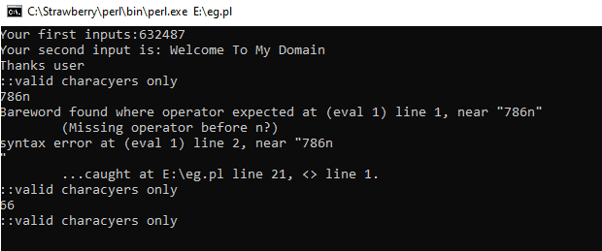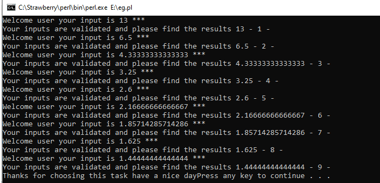Updated April 12, 2023

Introduction to Perl eval
The Perl eval is defined as one of the functions that can be used for to evaluate the given user inputs it may be any data types like strings, integer or numbers mainly its validate the string characters line by line the evaluation will be any user inputs even though files are to be handled with some exceptions and errors also by using the loops the datas or input values to be iterated with the possible set of values but it takes some time consuming for each set of variable values the strings are split and joined by using some default methods it also been evaluated.
Syntax:
The Perl eval function is used in various ways and it has the set of arguments with parameters which is required for validated the strings in Perl scripts. Eval function is used mainly in the loop section because the input values are to be validated and iterated in line by line of the scripts.
eval {
--some perl code scripts depends upon the user requirement—
}The above code is the basic syntax for the eval function which will be validated with all the perl script functions, variables, and keywords. Even though it will handle some exceptions and errors in both compile-time and run-time.
How does eval Function work in Perl?
The eval function not only validates the strings and user inputs it also handled the errors and exceptions for both compile and runtime scripts. It is one of the built-in and most exhausted functions in the Perl script. It can be used with other features like regular expression, error handling mechanism, Require functionality of the scripts, Timeout session for both application and servers, and Dynamic code generation validation these are some various categories are to be evaluated by using the eval function in scripts. When we use the error handling mechanism it will trappings from both compile and runtime some errors are to be file related issues that is “file not found exception” etc. If we use regular expression in the string variable types it uses both numbers, characters, operators, and symbols, etc. Whatever the input values are used in the eval block it should be validated once when the script is to be executed. If we regular expression feature in the script it actually reduces the input lines in the code and also it should be validated when the matched strings or corresponding characters used in the given strings. So that time it takes more number of lines in the script and also the execution time also been more when compared to the normal script sessions. Basically, the number of list type regular expressions can be put into any containers or storage areas like hash, map, array collections, etc by using the loop conditions each user input values are to be validated with line by line for the expression. If we use hash collection functions it always calculates and used as the key-value pair in the function arguments. But when we use arrays it has single, multi-dimensional arrays for each element that has a separate index value and it creates the memory for storing the variable values with the memory space. These are the test case scenarios are to be evaluated when we use regular expression in the script also its to be used inside of the eval block for validation purpose of the script.
At the same time when we use the file handling feature in the Perl script, it is used for some trapping errors because each small type of errors will perform the execution time of the scripts so the subroutines of each programming sections will cause some end time because of these errors or user-defined function is to be called in both internally and externally. The eval block codes always executed so the block won’t carries for the errors and exceptions. But it always captured the user-defined errors, syntax errors in compile time as well as runtime code snippets. Some types of errors are not caught when we use the eval function like “uncaught signal errors, Running out of memory in the storage areas, user-defined syntax errors” these errors are compile-time errors so the programmer identifies their mistakes easily and can be corrected for the execution. Likewise File handling concepts with some formats like zip, tars, etc, and dynamic code generation so that trusted and untrusted data are to be evaluated in the scripts.
Examples
Let us discuss examples of Perl eval.
Example #1
Code:
$var = <>;
%first = (
num => qr/^[0-9]+-$/,
chars => qr/^[a-zA-Z]+$/
);
while( my ($ke,$vals) = each(%first) ) {
if(eval"$var =~ /$vals/") {
print "Welcome users your based on your inputs your result is:$ke\n";
}
else
{
print "Please enter any valid inputs from your end:\n";
}
}Output:
Example #2
Code:
$val1 = 632487;
print"Your first inputs:$val1\n";
$val2 = "Welcome To My Domain";
print"Your second input is: $val2\n";
eval{$result=$val1 + $val2;};
if($@){
print "Your input is validated";
}
print "Thanks user\n";
do {
print("::");
print("valid characyers only \n");
chop($_ = <>);
eval($_);
warn() if $@;
} while ($_ ne "Thanks users given inputs are not validated");Output:
Example #3
Code:
use File::Slurp;
use strict;
use warnings;
my $userinputs = read_file('E:\\yt.txt');
my $inputcontents = "Welcome To My Domains\n";
eval ($userinputs);
if($@){
print "Thanks user your file is created";
}
my $us;
my $re;
for $us(1..9) {
eval {$re = 13 / $us; print "Welcome user your input is $re ***\n";};
print "Your inputs are validated and please find the results $re - $us - $@\n";
}
print "Thanks for choosing this task have a nice day";Output:
Conclusion
The scripting language as well as other object-oriented languages it needs some validations for the user input values. So they require more attention for their input values as well there are no data losses when they use some default validation functions as well as scripts. Among those eval() function performs some user inputs validations without any data losses.
Recommended Articles
This is a guide to Perl eval. Here we discuss the How does eval function work in Perl with examples and its code implementation. You may also have a look at the following articles to learn more –




